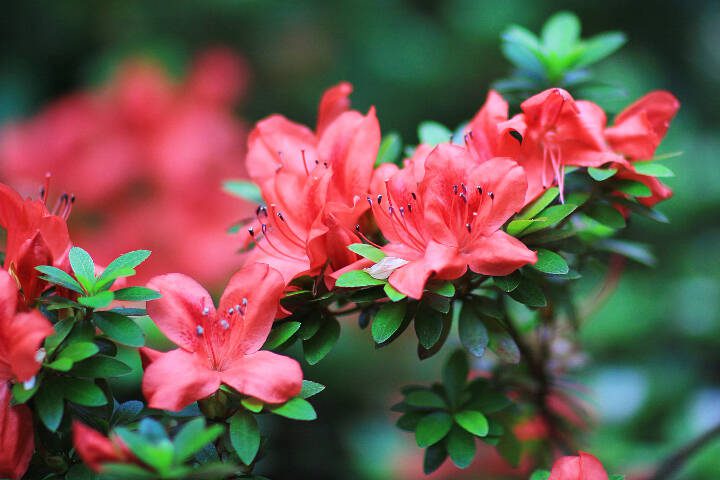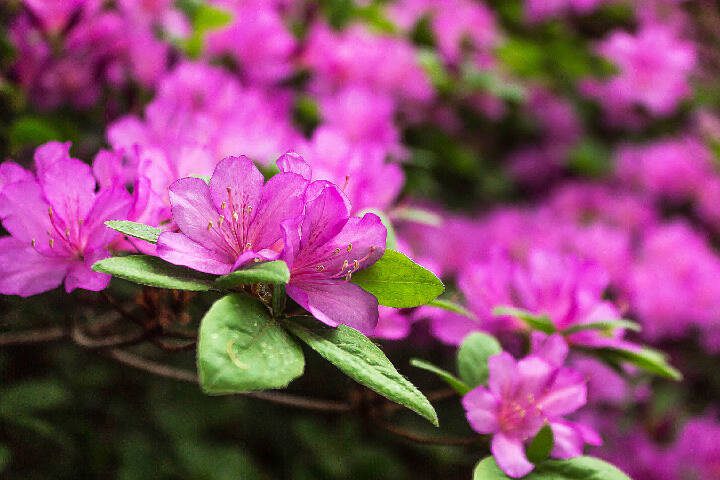By Trevor Cameron / The Golfing Gardener
One tried and true shrub for our local gardens is the azalea: a spring-flowering beauty that can be used in many locations in the landscape.
Related to the rhododendron, which is Washington state’s official flower, azaleas themselves offer spectacular flowers on smaller-growing plants that thrive in similar conditions. There are hundreds of options out there, including many old-fashioned favorites and some excellent newer choices, as well.
The golfing half of my “Golfing Gardener” persona is excited to highlight azaleas this week, in honor of the Masters Tournament — a tradition like no other. The hallowed grounds of Augusta National Golf Club play host to the Masters beginning Monday, making next week a special time of year for us golf geeks — not just for the golf competition but, in all honesty, for the plants, too.
The property that Augusta National lies on was a fabulous nursery in its previous life, and the members have allowed this place to flourish, over nearly a century, into what I would call an arboretum with a golf course that runs through it. There are holes named for plants such as Camellia, Nandina, Pink Dogwood, Redbud and, of course, Azalea, one of the best holes on the course: the treacherous 13th hole with a par 5, which is adorned with more than 1,000 Azalea specimens.
I would encourage all to tune into the Masters next week for a bit, if not for the golf than to enjoy the unbelievable vistas of plants on the property. In April, azaleas are always in bloom, not only at the Masters but in our own Pacific Northwest landscapes, too.
Evergreen varieties of azalea come with a vast array of colorful flower options, from white and pink to red, purple, salmon orange and all shades in between. If you want to go bold, we can find deciduous azaleas in true orange and yellow options, many with the added bonus of fragrance. (We will dive into greater detail on deciduous azaleas in a future column, I promise.)
Gardeners can select single blooms or semi-double blooms, and mix flavors for blooming color from early spring into early summer. To me, planting just one is never enough, as these shrubs are a lovely choice for planting in groups of three, even larger swathes or along borders in mass.
All azaleas enjoy our typical acidic soils and will thrive in any woodland garden with partial sun and shade, however, many will take full afternoon sun, as well.
Remember, a well-fed plant is a happy one, and azaleas are no exception. Using an organic acidic-type fertilizer is ideal, and applying it around the drip-line of these shrubs — once in February or March and once more in later May or June — works perfectly. Adding some mulch around the base will also help, being careful not to bury the crown or lower branches. These are by no means drought tolerant, so the mulch will help reduce watering needs, but be sure to monitor them in our drier summer months to ensure their continued happiness with maximum bud production for the next spring.
Pruning is easy. With both evergreen and deciduous azaleas, follow my simple rule: prune after bloom. This of course does not mean you have to prune them every year, but doing it right after flowering is ideal since a fresh flush of foliage will emerge and they will set their flower buds on branch tips over the summer, maximizing bloom the next spring.
It’s also easy to shear back evergreen azaleas, if you want a denser, more compact specimen with maximum bloom. But there is nothing wrong with letting them get a little taller with a more open habit. I shear some of my azaleas that are planted close to borders, but leave others to grow tall as background plants. Either way, you’ll have attractive, sturdy shrubs.
When looking to add some new azaleas to your landscape, it is important to note your sun and shade situation, your desired bloom time, your color preference, and how much height and spread your chosen spot can handle. There are many good varieties to choose from, but here are some of my personal favorites.
Oldies but goodies: Evergreen varieties such as Hino Crimson (still sets the standard for bright red color in early spring and will take some heat), Girard’s Fuchsia (large fuchsia purple flowers, taller growth and lovely burgundy foliage in winter months), Coral Bells (striking, semi-double coral-pink blooms that are better in part shade), Silver Sword (sweet, variegated silver-green foliage and large, dark rose-pink flowers) or Everest (later-blooming, large white flowers that like morning sun).
Double Shot azalea series: There a few flavors in this newer series, including Grape and Watermelon, but they’re actually a hardier option than others I see around our area for reliable flowers twice a year, in spring and fall. They are somewhat taller growers with age but can be pruned after spring flowering to control size (avoid pruning them in fall after fall bloom).
Satsuki-type azaleas: These late-spring bloomers offer huge flowers in shades of mainly white, pink and salmon, with often one plant having multiple colors, or even individual flowers on the same plant having multiple colors. Seek out ones such as Eikan, Getsutoku and Higasa, all of which are great choices for part shade and are usually available at your local garden center by late spring.
Kimono azalea series: Excellent newer flavors such as Maraschino, May Snow and Canzonetta bloom heavily and stay very tidy and compact in shape. They bloom mid to late spring, and some varieties offer wonderful winter foliage color, as well. They are excellent for lower border plantings in mostly sun, except May Snow, which prefers a little shade in the afternoons.
Spring is the perfect season to gaze upon the beauty of azaleas as you travel about, and certainly an ideal time to view them in bloom in local garden centers. Whether evergreen or deciduous, azaleas will provide some amazing flower power to your home landscape each spring.
Free classes
Sunnyside Nursery in Marysville will host “New & Exciting Plants For 2024” at 10 a.m. on Saturday, April 6, and “Japanese Maples: The Tree For All Seasons” at 10 a.m. on Saturday, April 13. For more information or to sign up, go to www.sunnysidenursery.net/classes.
Trevor Cameron is a certified professional horticulturist (CPH) and serves as general manager for Sunnyside Nursery in Marysville. He can be reached at sunnysidenursery@msn.com.
Talk to us
> Give us your news tips.
> Send us a letter to the editor.
> More Herald contact information.


























